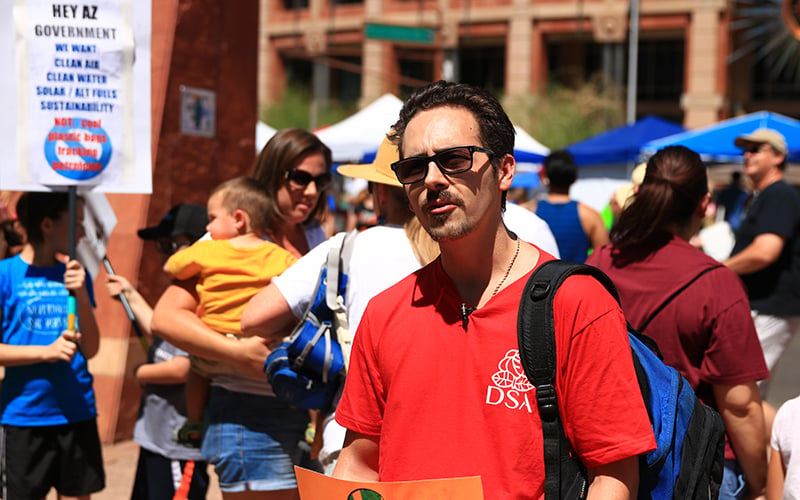
Phoenix Democratic Socialists of America member Trevor Keeley attended the March for Science with other DSA members. (Photo by Christopher Silavong/Cronkite News)
PHOENIX – The election of President Donald Trump has ignited the progressive movement, sparking weekly marches and protests throughout his presidency.
Although Democrats and leftists have united in their opposition to Trump, experts say there’s still a gaping wound that hasn’t healed after the Democratic primary.
The Democrats are trying to bring in supporters of Vermont Sen. Bernie Sanders, who lost the presidential nomination to former Secretary of State Hillary Clinton. That’s why Tom Perez, Democratic National Committee chairman, and Sanders stopped in Arizona in April for their “Unity Tour” aimed at healing that wound and working toward Democratic victories in local, state and congressional seats in 2018.
However, Democrats continue to struggle with bringing in many Sanders supporters, who blame the Democratic National Committee for favoring Clinton behind the scenes, citing hacked emails released by Wikileaks.
Some Sanders supporters are done with the Democratic Party, said Steven Slugocki, the Maricopa County Democratic Party’s chairman.
“There are still hurt feelings from the primary last year,” Slugocki said. “It’s unfortunate because we’re a big tent. I want to welcome all groups.”
One Arizona Sanders fan has a different strategy.
“Our goal is to work with the Democrats and pull them to the left … to shift everybody back,” said Phoenix resident Jake Bell, a member of the Democratic Socialists of America.
The DSA is separate from and further left of the Democratic Party, which became centrist during the 1990s.
The DSA, founded in 1982, said its membership spiked by nearly 175 percent after the presidential election, from about 7,600 members to more than 20,700, according to its national office. The DSA credits its growth to Sanders openly campaigning as a democratic socialist, once believed to be political suicide in American politics. The group has about 225 members in Arizona, the spokesperson said.
The group’s membership and visibility pales in comparison to organizations such as Indivisible, which burst onto the political scene in late December. But the Democratic Socialists of America’s structure, unlike Indivisible, isn’t based on loose associations like that of the Black Lives Matter movement. The growing membership has led to more local groups and branches.
Bell said that a Phoenix chapter is in the works, and they plan to do more than “resist,” which means putting forth new policies in the legislature, serving the community, performing charity work and volunteering.
“Deeds are more than words,” he said.
What is democratic socialism?
Leftists groups once considered fringe by modern American political standards seeped into the national consciousness during Sanders’ campaign. He unapologetically called himself a democratic socialist, giving the old term a new audience.
The term socialism, for many, stokes memories of the Soviet Union and Maoist China – authoritarian dictatorships. But, like liberalism and conservatism, there’s a spectrum.
Democratic socialism emphasizes “decentralization,” said Tara Lennon, a lecturer at Arizona State University’s School of Politics and Global Studies. This means they oppose government running most aspects of society while advocating employee ownership of business.
The U.S. has had a long democratic socialist tradition stemming back to the progressive era in the late 19th and early 20th century. Progressives and socialists fought for many policies, including minimum wage, overtime pay, an eight-hour work day and labor rights.
Arizona’s constitution even began with a few progressive ideas. Article XVIII defined an eight-hour work day and regulated child labor. The framers also included a provision for citizen initiatives, which has been under attack since Arizonans voted to raise the minimum wage.
Arizona: More purple than red
Most people recognize Arizona as a red state – Republicans control the legislature, governor’s office, secretary of state and state treasurer’s offices. But actually, the state’s voting population is more nuanced.
According to the secretary of state’s most recent count of active registered voters, about 30 percent are Democrats, about 34 percent are Republican and nearly 34 percent identified as “other.”
However, this does not mean that progressive groups and their members are registered as Democrats. Some might have registered as independents and lean Democrat, while others might not bother voting at all.
Although Democrats only make up a third of registered voters, the party has seen a surge in turnout, activism and engagement, Slugocki said.
“We have seen a tremendous amount of growth in all our districts,” Slugocki said. “There’s so much going on (that) it’s sometimes hard to keep track of.”
Typically, Slugocki said, political campaigns start near the beginning of an election year, but several people already have announced for state offices.
“It’s an exciting time for the county party,” he said. “It’s a wild ride, and I’m not quite sure where we’re going to be a year from now, but we’re in a better position than ever to win elections.”
But Arizona Democrats alone won’t get their nominees elected to state offices and legislative seats. They may have to sway independent progressives and other leftists, who are still angry about the primary, into the voting booths. Democrats will have to send the right message and follow up with action.
“I am more than willing to help (outside groups),” Slugocki said, but for groups that reject the party, he wishes them luck.
“Hopefully, we can all accomplish the same goals,” he said.